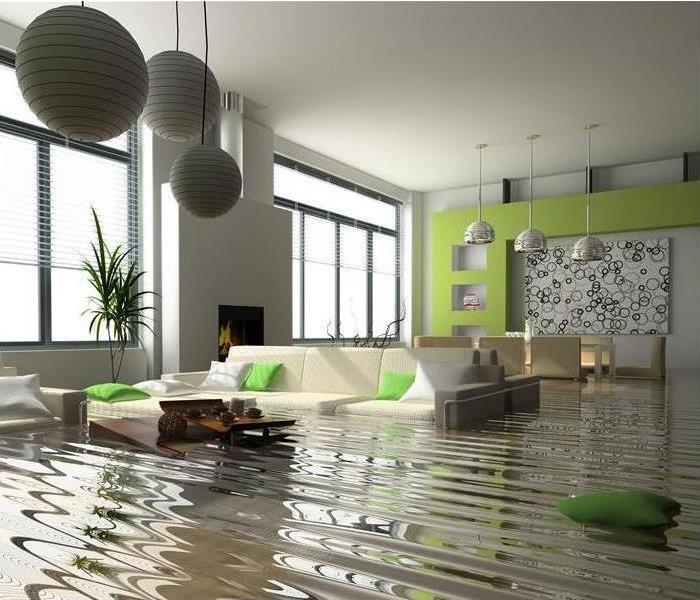Archived Water Damage Blog Posts
Water Damage In Washington, DC
9/8/2022 (Permalink)
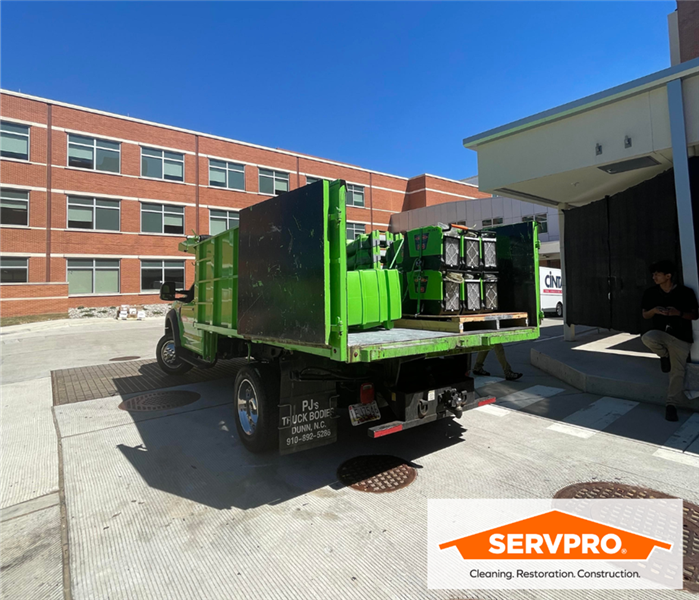 Our certified technicians respond to a water damage loss at a local hospital
Our certified technicians respond to a water damage loss at a local hospital
SERVPRO of Washington, DC is the answer to water damage in your home or business.
Water damage in your home or business needs immediate attention. Water damage caused by storm flooding or a leaky pipe needs immediate attention. If you do not address the situation quickly you could end up with serious issues like mold. Trying to self-mitigate water damage can be tricky. The best approach to water damage is to call SERVPRO of Washington, DC certified technicians.
Our certified technicians respond to a water damage emergency with a detailed inspection of your home or property. At this point, our technicians will try to determine the scope of the damage so that we can develop an appropriate plan of action. The level of contamination of the water will affect the specific restoration process we use.
Category 1: "Clean Water"
Category 2: "Gray Water"
Category 3: "Black Water"
Our certified technicians will inspect and test the extent of damage and how far the moisture has traveled to ensure proper and complete restoration. Our team will also inspect for safety concerns that may be evident. If there are any safety issues like lead or asbestos, please bring them to our attention.
SERVPRO of Washington, DC specializes in the cleaning and restoration of commercial and residential properties after a fire, smoke, or water damage event. Our staff is highly trained in property damage restoration. From initial and ongoing training at SERVPRO’s corporate training facility to regular IICRC-industry certification, rest assured our staff is equipped with the knowledge to restore your property.
Flooding and water emergencies don’t wait for regular business hours and neither do we. SERVPRO of Washington, DC provides emergency cleaning and restoration services 24 hours a day, 7 days a week, including all holidays.
SERVPRO of Washington, DC (202) 737-8776
Hidden Water Damage and Mold in Your Home
4/19/2022 (Permalink)
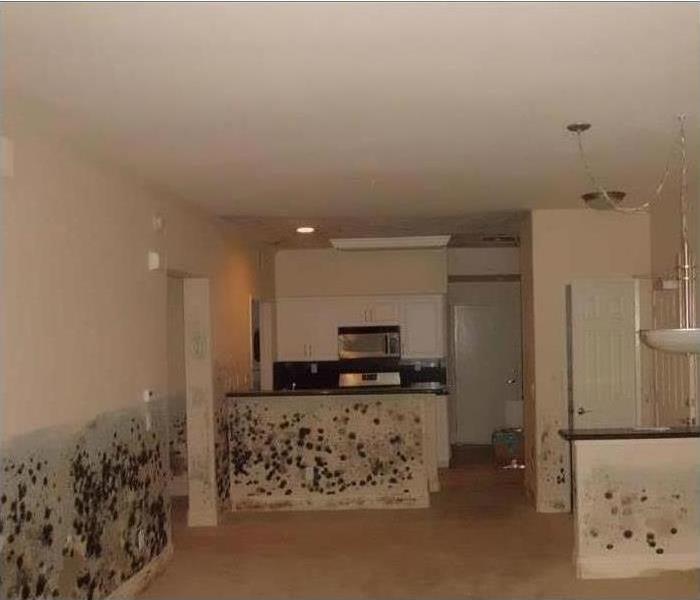 Contact SERVPRO of Washington DC for water damage and mold remediation services (202) 737-8776.
Contact SERVPRO of Washington DC for water damage and mold remediation services (202) 737-8776.
There are a number of things that can cause water damage in your home. Leaky pipes that you can't see, broken appliances, and even rain and flooding. What is important to remember is to call the professionals at SERVPRO of Washington DC if you have water damage or suspect mold. There are some things to keep in mind until help arrives.
If you see visible mold, do not disturb it. You can inadvertently spread the mold infestation throughout your home. When mold is disturbed, the mold can release microscopic mold spores which become airborne and can circulate inside your home.
What to Do:
Stay out of affected areas.
Turn off the HVAC system and fans.
Contact SERVPRO of Washington DC for mold remediation services (202) 737-8776.
What Not to Do:
Don’t touch or disturb the mold.
Don’t blow air across any surfaces with visible or suspected mold growth.
Don’t attempt to dry the area yourself.
Don’t spray bleach or other disinfectants on the mold.
About Our Mold Remediation Services
SERVPRO of Washington DC specializes in mold cleanup and restoration, in fact, it’s a cornerstone of our business. Our crews are highly trained restoration professionals that use specialized equipment and techniques to properly remediate your mold problem quickly and safely.
If You See Signs of Mold, Call Us Today (202) 737-8776
Getting Ahead of Roof Leaks in Washington DC
2/23/2022 (Permalink)
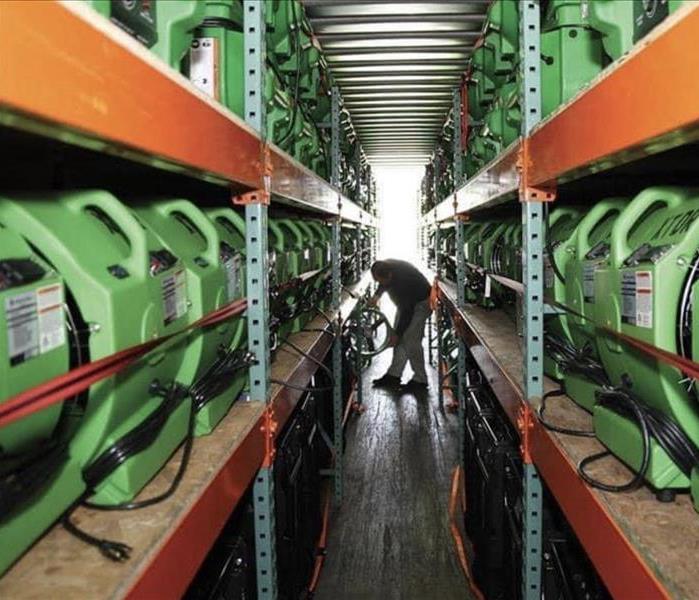 SERVPRO of Washington DC, our equipment is always ready to go, when you need help.
SERVPRO of Washington DC, our equipment is always ready to go, when you need help.
Storms, wind, snow and ice cause several issues with a roofing in the Washington DC area. One big risk is that water may seep past the barrier of protection that the roof provides your home. The water may saturate the wooden structural support system of your home. This will soon weaken and possibly fall apart from water damage.
It is best if you know how to find a roof leak to catch the problem before it is too late.
Moisture or Dark Water Spots
You may notice less severe symptoms, such as dark water spots on your ceiling. Moisture without a clearly identifiable source could be a sign of a roof leak. Water spots on the lower levels may be a sign of internal water leaks from a bathtub, toilet, or other appliance.
Granules
If you take a closer look at your shingles, note the consistency of the granules attached to them. Granules are small pebble-like pieces that help protect your roof from the sun. If there are large portions of your roof missing granules, you might need to consider repair or replacement.
Dark Stains on Roof
If the shingles have any abnormal appearance, you know that a leak is certainly a risk. This implies that your home is much more exposed to the elements and vulnerable to damage from the weather.
Ceiling Issues
A bulging ceiling may indicate that water is building up without draining from the ceiling. It can cause even more serious damage by completely falling into the room below.
If you have a leaky roof or other water damage in your home, call SERVPRO of Washington DC (202) 737-8776. We specialize in water damage restoration, it's the cornerstone of our business.
SERVPRO of Washington DC has the specific water damage training and experience to help you restore your home. Our crews are highly trained restoration professionals that use specialized equipment and techniques. A fast response lessens the damage, limits further damage, and reduces the restoration cost. We can get to your emergency faster because we are locally owned and operated. We are able to respond, with the right resources, which is extremely important.
Training That Makes a Difference
SERVPRO of Washington DC is an IICRC firm. The Institute of Inspection, Cleaning and Restoration Certification (IICRC) creates the standards for the restoration industry and provides training and certification to restoration companies.
Quick Response to Washington DC Commercial Damage
2/16/2022 (Permalink)
 SERVPRO technician is cleaning water damage in a commercial property. If you have questions about restoration, SERVPRO of Washington DC (202)737-8776
SERVPRO technician is cleaning water damage in a commercial property. If you have questions about restoration, SERVPRO of Washington DC (202)737-8776
Recently, a local business called us about water damage. Our technicians were able to respond and access the damage. Clean-up started quickly and our staff was able to use their valuable training.
SERVPRO of Washington DC is an IICRC firm. The Institute of Inspection, Cleaning and Restoration Certification (IICRC) creates the standards for the restoration industry and provides training and certification to restoration companies. IICRC Certified Firms have the right to display the IICRC Certified Logo.
When you are dealing with water damage, immediate action is crucial. A delay of just a few hours can greatly increase the severity of the water damage. SERVPRO of Washington DC is available 24 hours a day for water emergencies, large or small.
When dealing with water damage, mold can sometimes be an issue. This is another reason that it's important bring in professionals to restore your home or business. SERVPRO of Washington DC provides emergency cleaning and restoration services 24 hours a day, 7 days a week.
Cleaning Up Before the Mold Can Spread
Microscopic mold spores naturally occur almost everywhere, both outdoors and indoors. This makes it impossible to remove all mold from a home or business. Therefore, mold remediation reduces the mold spore count back to its natural or baseline level.
Here to help, with the right equipment and training. If your home or business has a mold problem, we can inspect and assess your property and use our specialized training, equipment, and expertise to remediate your mold infestation.
The SERVPRO of Washington DC team is always ready (202)737-8776.
Washington DC, Mold in Water Damaged Homes
1/27/2022 (Permalink)
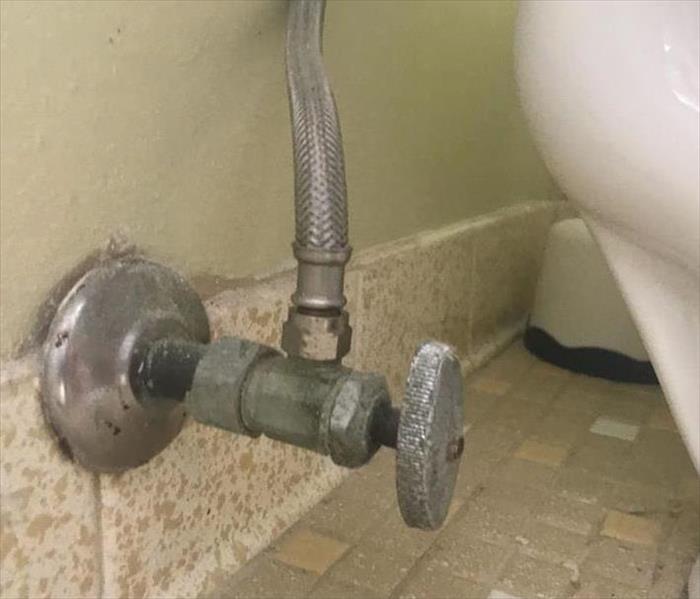 SERVPRO of Washington DC teams quickly extract the water and then dry your property using state-of-the-art equipment (202) 737-8776
SERVPRO of Washington DC teams quickly extract the water and then dry your property using state-of-the-art equipment (202) 737-8776
Tracking Leaks in Your Home
If you suspect you may have pipes that are leaking in your home, don't hesitate, try to locate the problem right away. You can begin by starting to look for water damage.
Water damage often shows up as brown stains in your ceiling or walls. If your house has vinyl flooring or wallpaper, look out for areas where it has begun to peel or bubble. It may even be possible to see mold growing.
If you have an idea of where the leak is, run your hands along the wall looking for cold spots in the wall, or for flaking paint. This method can be unreliable as the cause of cold spots can simply be cold water lines.
The sound of dripping water is annoying, especially when you can't find the source. If you hear dripping water, and you’ve made sure that all your faucets are off, you may have a hidden leak and it's time to call for help. In Washington DC, mold can spread through a home in as little as 48 hours.
SERVPRO of Washington, DC has trained restoration professionals that can help with your water damage. Most water damage requires professional odor removal and deodorization since wet materials have a distinct smell.
SERVPRO of Washington, DC can simplify the restoration process by handling both the initial mitigation and rebuilding damaged areas. If your home has a mold problem, we can inspect and assess your property and use our specialized training, equipment, and expertise to handle your mold remediation.
Call SERVPRO of Washington, DC and let our trained, professional crews handle the situation (202) 737-8776.
Water Damage in Washington DC, Who Should You Call?
11/29/2021 (Permalink)
When you have a water emergency you don't have time to sort through all of the companies claiming to be the best. What sets one company apart from the rest? We believe there are a number of factors you should consider.
If you have a water emergency right now, call SERVPRO of Washington, DC (202) 737-8776, you can come back and read the blog later.
Choosing A Leader in Water Restoration
SERVPRO of Washington, DC specializes in the cleanup and restoration of commercial and residential property after a water damage event.
Whether we’re dealing with a relatively small water cleanup scenario or a large-scale event, we work quickly to assess each unique situation and isolate the damaged area. We can respond immediately to your emergency and have the expertise to handle your restoration or cleaning needs.
Our staff is highly trained in property damage restoration. From initial and ongoing training at SERVPRO’s corporate training facility to regular IICRC-industry certification, rest assured our staff is equipped with the knowledge to restore your property.
SERVPRO of Washington, DC provides 24-hour emergency service and is dedicated to being faster to any-sized disaster. Since we are locally owned and operated, we are able to respond quicker with the right resources, which is extremely important. A fast response lessens the damage, limits further damage, and reduces the restoration cost.
Water damage that is not addressed quickly can lead to mold. Mold spores can quickly grow into colonies when exposed to water. Before mold remediation can begin, any sources of water or moisture must be addressed. Otherwise, the mold may return.
If you have water damage or suspect mold call SERVPRO of Washington, DC (202) 737-8776.
Water Damage In Washington DC, A Hidden Leak Could Lead To Costly Repairs
9/9/2021 (Permalink)
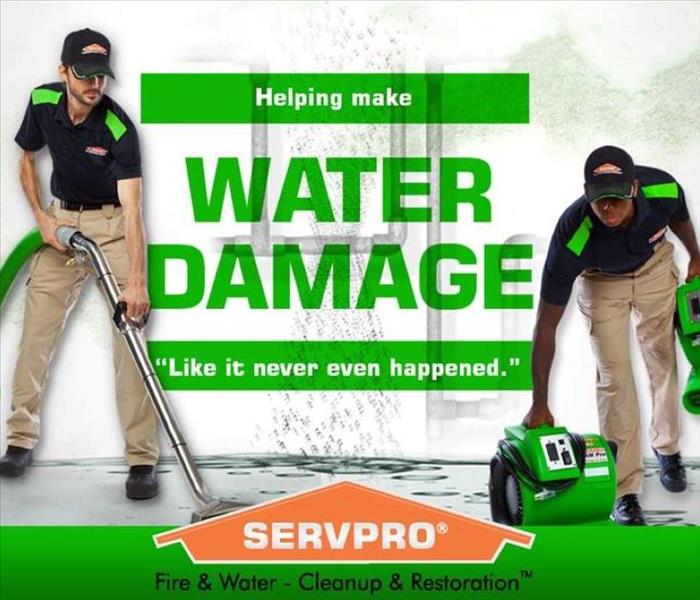 SERVPRO of Washington D.C. specializes in the cleanup and restoration of residential and commercial property after a water damage event.
SERVPRO of Washington D.C. specializes in the cleanup and restoration of residential and commercial property after a water damage event.
Signs you have a hidden leak
If you notice any of the following, you may have a leak somewhere in your home:
You hear water running without any open faucets
You notice signs of mold or mildew
Your tile or concrete floors feel warm
You have excessively high water bills, with no extra usage
Your carpets feel wet or damp
What causes pipes to leak?
The material of your pipes: Some pipe materials wear out faster than others, causing them to spring a leak. We especially see leak problems with copper pipes (pinhole leaks).
Hard water: If you have hard water, which means you have corrosive minerals in your water supply. These minerals can wear down pipes, especially if the pipe is made out of weak material.
Lightning or construction damage: Both of these can cause pipes to crack and form leaks.
The conditions of your soil: Some of the minerals found in soil can corrode pipes. Additionally, if soil shifts under your foundation, it can increase pressure on the pipes, eventually causing a leak.
SERVPRO of Washington D.C. specializes in the cleanup and restoration of residential and commercial property after a fire, smoke or water damage event.
Our staff is highly trained in property damage restoration and we are an IICRC Certified Firm. We believe in continuous training: from initial and ongoing training at SERVPRO’s corporate training facility to regular IICRC-industry certification, rest assured our staff is equipped with the knowledge to restore your property.
The IICRC standards take years to develop and require the coordination of experts in the field: manufacturers, industry organizations, insurance professionals, training schools, contractors, and public health professionals.
The IICRC has been the driving force in establishing the main industry standards and reference guides for professional carpet cleaning, water damage restoration and mold remediation.
SERVPRO of Washington DC provides 24-hour emergency service and is dedicated to being faster to any-sized disaster.
We can respond immediately to your emergency and have the expertise to handle your restoration or cleaning needs. If you have questions about water damage or restoration in general call us today (202) 737-8776.
Water Damage From Storms And Flood
4/21/2021 (Permalink)
Floods And Damage Across Several States
Storms and heavy rains can cause heavy flooding in a short period of time. Certain parts of the country experienced heavy rains earlier this year. People experienced dangerous storm water and flood damage in 6 states in early March. The National Weather Service is warning that rivers will stay in flood stage for days. The flood waters forced evacuations and millions in damage.
After The Flooding
Flooding means that not only will a homeowner have to think about the current situation of being displaced from their home and losing some of their personal belongings, but the results after the water is gone. Standing water is a breeding ground for bacteria.
Once the water has subsided the presence of dirt, grime, bacteria and mold will be present. The level of expensive damage depends on how long the standing water is left unattended. There is no telling when the water can be extracted from the towns let alone peoples houses.
After the waters have subsided and before you immediately enter your home refer to this checklist.
1. Watch out for wild animals, poisonous snakes that may have entered the home, check thru the debris.
2. Watch out for plaster, loose ceiling structures and document everything for yourself and for insurance purposes.
3. Throw away any food, anything that may have come in contact with the flood waters, anything in the fridge.
4. Check electrical systems, gas leaks, sewage and water lines all for damage.
Call SERVPRO of Washington DC (202) 737-8776. Even if your flood damage is not as dramatic as what we saw in the south earlier this year, we'll be there to help.
SERVPRO of Washington DC specializes in storm and flood damage restoration. Our crews are highly trained and we use specialized equipment to restore your property to its pre-storm condition.
We'll Get To You Faster
Since we are locally owned and operated, we are able to respond quicker with the right resources, which is extremely important. A fast response lessens the damage, limits further damage, and reduces the restoration cost.
Water Damage In Washington DC
4/19/2021 (Permalink)
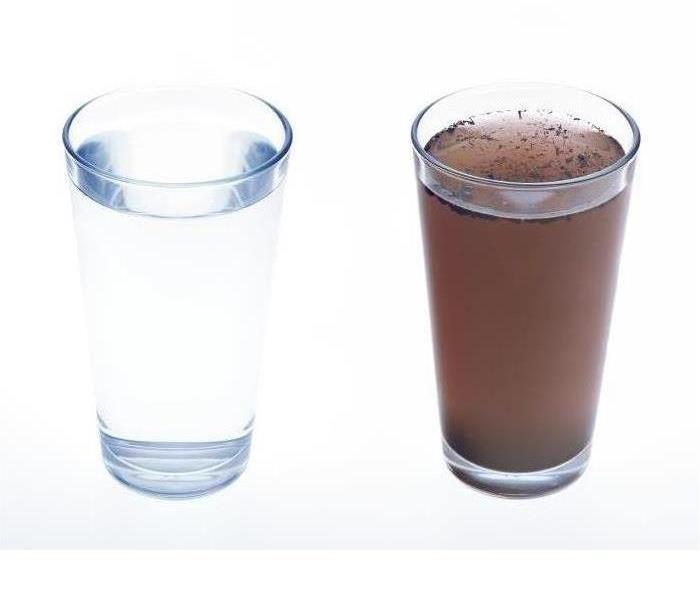 Contaminated water can be a lot to handle, SERVPRO of Washington DC is here to help (202) 737-8776
Contaminated water can be a lot to handle, SERVPRO of Washington DC is here to help (202) 737-8776
Washington DC Water Damage
Damage from Clean Water:
· Shut off the water source if possible or contact a qualified professional to do so.
· Turn off circuit breakers for wet areas of the building, if access to the power distribution panel is safe from potential electrical shock.
· Remove as much excess water as possible by mopping and blotting.
· Wipe excess water from wood furniture after removing lamps and tabletop items.
· Remove and prop up wet upholstery cushions for even drying.
· Place aluminum foil or wood blocks between furniture legs and wet carpeting.
Damage from Contaminated Water:
· Avoid all contact with sewage and items contaminated by sewage.
· Do not walk through contaminated areas, as you could spread damage to unaffected areas.
· Do not turn on HVAC system if there is a possibility of spreading contaminated air.
· Do not use household fans to dry the structure; air flow could spread contaminants.
· Discard any food and/or products for personal hygiene and cleanliness if exposed to the contaminated areas.
SERVPRO of Washington DC is here to help. Give us a call if you have water damage or additional questions. (202) 737-8776.
SERVPRO of Washington DC is available 24 hours a day for water emergencies, large or small. When you are dealing with water damage, immediate action is crucial. A delay of just a few hours can greatly increase the severity of the water damage.
We understand that when you call us, you may be feeling confused, stressed, and vulnerable. You need an expert to guide you through this crisis. SERVPRO of Washington DC has the specific water damage training and experience to help you through this tough time. We specialize in water damage restoration—in fact, it's the cornerstone of our business.
A Flooded Basement Can Lead To Structural Issues And Mold
3/25/2021 (Permalink)
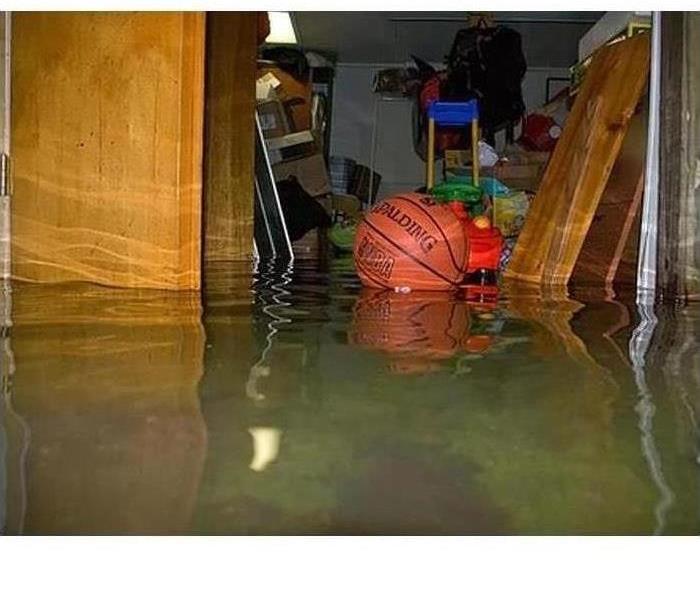 When severe weather threatens your home, SERVPRO of Washington DC technicians are available to help (202) 737-8776
When severe weather threatens your home, SERVPRO of Washington DC technicians are available to help (202) 737-8776
Heavy Rain Can Mean Big Problems For Your Basement
A basement can flood at any time, although Washington DC flooding most often occurs during heavy rainfall. Basements are inherently prone to flooding because they are the lowest level of a building and are normally built partly or entirely below ground level.
There are a number of reasons why your Washington DC basement could flood, including:
A blocked or failed sewer lateral pipe
Heavy rain causes surface water to pool around your home
Storm sewer backup
Sanitary sewer backup
Foundation drainage failure
Water supply-line break or hot-water tank failure
Have Questions about Basement Flooding?
Call Today – 202-737-8776
If flood water is not handled quickly and properly, it can cause severe damage to your home’s structure. Remember, the longer you wait, the worse the problem will get. Mold is also a threat if the water damage isn't treated.
If your home or business has a mold problem, we can inspect and assess your property and use our specialized training, equipment, and expertise to remediate your mold infestation.
If You See Signs of Mold, Call Us Today SERVPRO of Washington DC (202) 737-8776
A flooded basement can jeopardize your safety, and your home’s integrity.
It’s worth making a call to SERVPRO of Washington DC and let our trained crews handle the situation safely and correctly. We have earned the trust of hundreds of homeowners, business owners, and property professionals.
We are Flooded Basement Specialists:
We are Available 24 hours/7 days per week
We’re a Preferred Vendor to many National Insurance Companies
We Bill The Insurance Directly – One Less Thing For You To Worry About
Our Technicians are Highly-Trained in Water Restoration Techniques
We use s500 IICRC Restoration Standards
Advanced Inspection and Extraction Equipment
SERVPRO of Washington DC technicians are available to help (202) 737-8776
Heavy Rains, Flash Floods And Water Damage In Washington DC
3/23/2021 (Permalink)
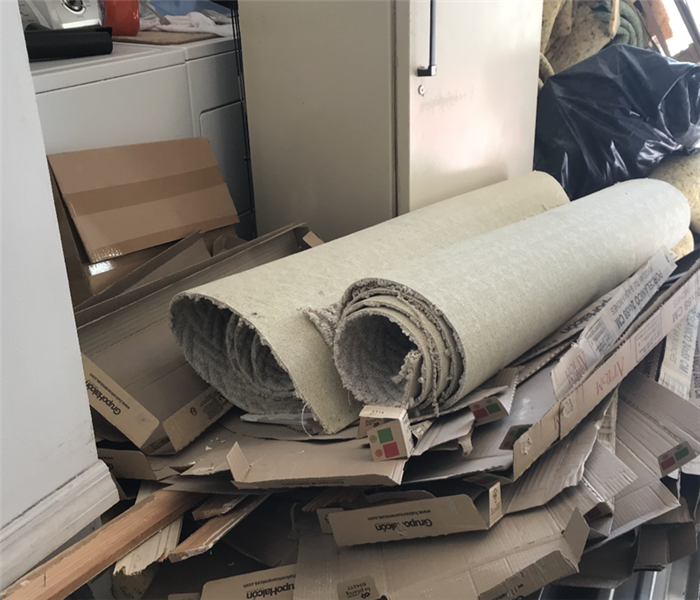 Don't let flooding and water damage leave your home a mess. Call SERVPRO of Washington DC (202) 737-8776
Don't let flooding and water damage leave your home a mess. Call SERVPRO of Washington DC (202) 737-8776
Flooding And Water Damage To Your Home In Washington DC
Weather patterns in the Washington, DC area can be unpredictable. Flash flooding, heavy rains, and road closures are part of life in the metro area.
Sometimes floods develop slowly and forecasters can predict where a flood will happen well in advance.
There are times that flash floods occur in minutes and even on occasion, without any sign of rain. The National Weather Service (NWS) believes being prepared can save your life and give you peace of mind.
National Weather Service recommends following these tips before a flood:
1. If you have access to sandbags or other materials, use them to protect your home from flood waters if you have sufficient time to do so. Filling sandbags can take more time than you may think.
2. Have a professional install check-valves in plumbing to prevent flood waters from backing up into the drains of your home. Make sure your sump pump is working and consider having a backup. Make sure your electric circuit breakers, or fuses, are clearly marked for each area of your home.
3. Since standard homeowners insurance doesn't cover flooding, ensure coverage by contacting your insurance company or agent to purchase flood insurance. This must be done before there is even a threat of flooding as insurance companies stop issuing policies if there is a threat of flooding. (i.e. an approaching hurricane). Many flood insurance policies take at least 30 days to go into effect so even if you can buy it as a storm is approaching, it may not protect your investment.
After The Flooding
If your home is damaged by flooding don't hesitate to call the experts at SERVPRO of Washington, DC (202) 737-8776.
SERVPRO of Washington DC specializes in storm and flood damage restoration. Our crews are highly trained and we use specialized equipment to restore your property to its pre-storm condition.
Training And Experience
SERVPRO of Washington DC is an IICRC firm. The Institute of Inspection, Cleaning and Restoration Certification (IICRC) creates the standards for the restoration industry and provides training and certification to restoration companies. IICRC Certified Firms have the right to display the IICRC Certified Logo.
SERVPRO of Washington DC provides 24-hour emergency service and is dedicated to being faster to any-sized disaster. We can respond immediately to your emergency and have the expertise to handle your restoration or cleaning needs.
If you have questions about water damage, mold, fire damage or other restoration call us SERVPRO of Washington, DC (202) 737-8776.
Water Damage | What is Covered Under Rental Insurance?
3/2/2021 (Permalink)
Depending on the type of policy, Renters insurance protects you against water damage caused by a number of situations that you may experience as a tenant in Montgomery County, such as accidental overflows or water discharge.
Accidental water damage incidents include:
- Pipe burst
- Machine malfunction (dishwasher, washing machine, etc)
- Plumbing.
- Damage to neighboring units
What Is My Landlord Responsible For?
Your landlord is responsible for the maintenance of your rental home, which includes preventing and fixing leaks. Any flaw in the building that could be linked to a possible future cause of property damage and water damage repairs must be reported.
Almost all rental agreements claim that you are not responsible for water damage repairs that are caused by structural issues if you inform your landlord in writing as soon as you find them. This involves leaks in the ceiling, assuming you aren't the one who caused them.
Double-Check Your Lease And Your Renter Policy
Although most policies cover losses caused by accidental water damage, call your insurance company and discuss what your rental insurance covers. Also, read your lease carefully. Make sure you understand your and those of your landlord's responsibilities in the event of a crisis. And in times of emergency, make sure your landlord knows to call SERVPRO of Washington, DC when water damage restoration services are needed.
Learn More About Our Water Damage Repair and Restoration Process
Home Water Damage - What Will My Insurance Cover?
1/14/2021 (Permalink)
Water damage is a common insurance claim among homeowners. If you are about to make a claim on water damage to your home it’s good to know what to expect. There are some items that homeowners generally have an easier time making water damage claims for than others.
Problem Areas
There are some losses that homeowners typically run into problems when trying to make a water damage claim to their insurance company. These include loss that resulted from gradual damage.
What Is Gradual Damage
Gradual damage is anything that happened over the course of a prolonged period, as opposed to an accident, or sudden damage, which happens as the result of one single event.
Will My Insurance Cover My Gradual Damage?
Loss such as leaky ceilings due to plumbing defects, water damage caused by cracks in the foundation, and in some cases, mold, fall under the category of gradual damage. These things are generally not covered by insurance. However, there may be some exceptions. For example, if mold was the result of another claim that was covered under insurance, but was not properly fixed, the insurance company would likely cover it.
Will My Insurance Cover My Water Loss?
On the other hand, if the water damage is sudden and accidental you’ll probably have a much easier time getting covered for the damages. This is the true nature of insurance – to cover accidents. Of course, everything is dependent upon the language of the policy that you purchased, but this is the very nature of insurance: coverage for sudden and accidental loss. A good practice for homeowners is to keep a record of all repairs and transactions for services that are made to your home.
About SERVPRO of Washington, DC.
At SERVPRO of Washington, DC, we are not only experts at restoring your home as if it never even happened, but we are also experts at dealing with insurance companies. For a stress-free claims process, SERVPRO can help manage the insurance paperwork and process. Contact us to learn more about how we can help you through the entire recovery process today!
Call SERVPRO of Washington, DC
What's in a Flood?
4/22/2020 (Permalink)
Not all water damages are the same. Many of our friends have found that out after recent flooding. The cleanup caused by recent flooding is much different than say a burst pipe you may have experienced in the past. In this blog we will look at the different water types.
What we call “clean” water when referring to water damage is water from a broken supply line for example. Clean water is pretty self-explanatory; it comes from a clean source. Rain water CAN be considered clean water if it is an isolated incident not related to wide spread flooding.
The second type of water is “grey” water. Grey water is slightly contaminated water. A good example of grey water is drain from a dishwasher. Keep in mind that water types can change. Clean water left too long without cleanup becomes grey water as bacteria and other contaminates can begin to grow.
The final classification is “black” water. Black water is highly contaminated as it is the result of encountering sewage, chemicals, or harmful bacteria. The tragic flooding we experienced this spring would be considered black water. Yes, we said earlier rain water was considered clean but as this water flowed out of control through farms and cities it picks up contaminates. Flooding to this extent has mixed with local sewage systems, as well as been in contact with an endless list of chemicals and contaminates.
SERVPRO always recommends you leave water damage cleanup to the professionals but we cannot stress enough how harmful black water can be. The type of water determines our protocol for proper cleanup. When handled improperly, it is easy to contaminate other areas of your home or business and instead of mitigating damage you may accidentally increase it. Black water should always be left to the pros.
Spring Mold Prevention
4/21/2020 (Permalink)
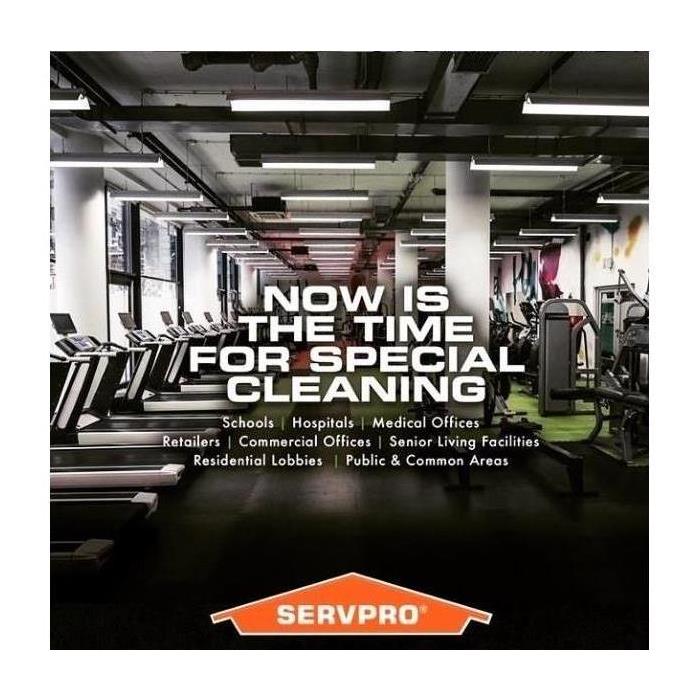
Birds are singing, flowers are blooming, and temperatures are getting warmer little by little. It’s evident that spring is in the air. Spring weather motivates us to open windows and breathe in the fresh air, but it may be surprising to know that doing so can increase the chances of mold growth in your home due to the presence of moisture and humidity in the air. Many different surfaces, such as carpet, wood, and insulation, can serve as reservoirs for mold as long as moisture is present. It is also important to note that mold is capable of growing at any point during the year, but warmer temperatures and greater humidity in the spring increase the risk of mold growth during the season. Understanding what actions you can take in order to prevent mold growth will prove absolutely essential in protecting your home and those living in it from the harmful effects of mold this spring.
It is extremely important when protecting your home from mold growth during the spring to facilitate the circulation of air within your home so that warm air will not become stagnant in one area. Air can be circulated efficiently with the help of fans and moisture in the air can be decreased through the use of a dehumidifier. It is important to remember that humidity levels indoors should not be greater than 45%. It may also be beneficial to keep an eye on areas of the home that are cold or dark, which are especially susceptible to mold growth. To help prevent mold growth in these areas, do your best to expose these areas to natural or artificial light.
Finally, after rain showers or storms, which are prevalent during the spring, make sure to frequently check areas around windows and doors for mold growth. Moisture from rain water can gather around windows and doors, which can lead to mold growth if not dried immediately. Additionally, because temperatures indoors and outdoors differ during the springtime, condensation is often prevalent on doors and windows. Moisture from condensation, when met with humidity, can also lead to mold growth if the area is not dried.
If mold becomes visible on a surface in your home, be sure to diligently scrub the surface with water and detergent. After doing so, make sure that you dry the surface thoroughly in order to prevent further mold growth in that area. Small-scale, isolated mold growth is typically manageable, but larger-scale mold growth can be overwhelming and require professional remediation. Call the mold remediation specialists at SERVPRO in order to assess the situation and take care of your home’s mold infestation in a timely manner.
Unexpected Water Damage
3/26/2020 (Permalink)
SERVPRO is available 24 hours a day for water emergencies, large or small. When you are dealing with water damage, immediate action is crucial. A delay of just a few hours can greatly increase the severity of the water damage.
We understand that when you call us, you may be feeling confused, stressed, and vulnerable. You need an expert to guide you through this crisis. SERVPRO has the specific water damage training and experience to help you through this tough time. We specialize in water damage restoration—in fact, it is the cornerstone of our business.
What to Expect
When you call us, we will ask questions regarding your water damage emergency. These questions will help us determine what equipment and resources to bring. This includes how many trained SERVPRO professionals we may need.
Our SERVPRO Representative will ask questions:
- Your name and contact information
- Your insurance information (if applicable)
- The street address of the water-damaged home or business
- When did the flooding or water damage occur?
- What caused the water damage (if known)?
- Is there electricity available (on-site)?
SERVPRO of Washington D.C. is here for you 24/7 all 365 days of the year. Call us at 202-737-8776.
Faster to Any Size Water Damage
3/26/2020 (Permalink)
SERVPRO provides 24/7/365 fire and water damage restoration service.
We do not wait for regular business hours. SERVPRO provides emergency cleaning and restoration services 24 hours a day, 7 days a week—including all holidays.
Faster To Any Size Disaster
Flooding and water damage is invasive. Water quickly spreads throughout your home and gets absorbed into floors, walls, furniture, plus more. SERVPRO arrives quickly and starts the water extraction process almost immediately. This immediate response helps to minimize the damage and the cleaning and restoration costs.
- Water quickly spreads throughout your property, saturating everything in its path.
- Water is absorbed into walls, floors, upholstery, and belongings.
- Furniture finishes may bleed, causing permanent staining on carpets.
- Photographs, books, and other paper goods start to swell and warp.
Hours 1 - 24:
- Drywall begins to swell and break down.
- Metal surfaces begin to tarnish.
- Furniture begins to swell and crack.
- Dyes and inks from cloth and paper goods spread and stain.
- A musty odor appears.
48 Hours to 1 Week:
- Mold and mildew may grow and spread.
- Doors, windows, and studs swell and warp.
- Metal begins to rust and corrode.
- Furniture warps and shows signs of mold.
- Paint begins to blister.
- Wood flooring swells and warps.
- Serious biohazard contamination is possible.
More Than 1 Week:
- Restoration time and cost increase dramatically; replacing contaminated materials and structural rebuilding may be extensive.
- Structural safety, mold growth, and biohazard contaminants pose serious risks to occupants.
If you need further assistance with your water damage, please call SERVPRO of Washington D.C. at 202-737-8776.
How to Prepare for a Flood
3/4/2020 (Permalink)
When living near a flood zone or if you are a first responder, it is important to prepare for a flood in advance. When a disaster takes place, keep these three flood response guidelines in mind.
1. The Right Immunizations
The Center for Disease Control recommends that all disaster responders receive a tetanus booster if they have not been vaccinated against this disease in the last 10 years. Either the tetanus/diphtheria or tetanus/diphtheria/pertussis vaccination can be used. Additionally, the CDC recommends the Hepatitis B vaccine for responders who plan to provide medical care.
2. Wear Protective Equipment
First responders should take precaution in protecting their skin from contaminated flood water. It is advised to wear electrically insulated watertight boots with a steel shank, toe, and insole. Hip waders can also limit exposure to standing water. A first responder should also wear thick, waterproof work gloves and safety goggles or glasses. Long pants or overalls, a long-sleeved shirt, and a protective head covering are also suitable for flood response work. If responders expect to enter locations that may be experiencing mold growth, a respirator may also be necessary.
3. Steer Clear of Moving Water
Flood water is threatening even if it does not seem deep. One may not be able to walk how they typically walk through water moving six miles per hour. Water has the capability of causing a loss of traction and footing when walking through it. Vehicles have the capability to float in 12 inches of water moving at the same speed. Exercising caution and only walking through flood water that is no more than four inches deep, not moving, and has a visibly hard surface underneath is a necessary safety measure.
Water Damage Timeline
1/17/2020 (Permalink)
Water Damage Timeline
Within Minutes
- Water quickly spreads throughout your property, saturating everything in its path.
- Water is absorbed into walls, floors, upholstery, and belongings.
- Furniture finishes may bleed, causing permanent staining on carpets.
- Photographs, books, and other paper goods start to swell.
Hours 1 - 24:
- Drywall begins to swell and break down.
- Metal surfaces begin to tarnish.
- Furniture begins to swell and crack.
- Dyes and inks from cloth and paper goods spread.
- An odor appears.
48 Hours to 1 Week:
- Mold and mildew may grow and spread.
- Doors, windows, and studs swell and warp.
- Metal begins to rust and corrode.
- Furniture warps and shows signs of mold.
- Paint begins to blister.
- Wood flooring swells and warps.
- Bio-hazard contamination is possible.
More Than 1 Week:
- Restoration time and cost increase dramatically. Replacing contaminated materials and structural rebuilding may be extensive.
- Structural safety, mold growth, and contaminants can pose serious risks to occupants.
Flood
3/11/2019 (Permalink)
The rushing floodwaters carried a lot of mud and silt from the exterior of this home and deposited the mess on the hardwood floors. Fast water and moisture removal are critical to limiting the water damage to the first onslaught of the storm waters. SERVPRO team members understand the importance of the initial day of cleanup and restoration. Minimizing non-salvageable materials to only contaminated elements for demolishing and discarding is a challenge. The After Photo illustrates the results that can be had when a professional outfit does the storm damage work. We can save our customers and their insurance companies money, inconvenience, and stress with a carefully laid out plan and then its execution.
The Science Behind Drying out Water Damage
3/4/2019 (Permalink)
Drying out water damage in customer's home
When Water Damage happens in your house the first things we all think about is to grab towels and mop up the water and finish with placing our house fans to dry up the area. Did you know that there is a Science of Drying and restoring your property?
With all the factors that go into what can happen with water damage its time that matters the most to help prevent other problems to arise. When you call SERVPRO we have the state-of-art equipment to speed up Mother Nature. When a property is wet it can naturally dry itself but also takes too long and with this process other damage such as mold and a weaken structure can happen creating more damage than if it was taken care of faster.
Here at SERVPRO we have the knowledge of psychrometrics which is essential to restoring water damage to its preloss condition. Our Team has been trained on all of the drying techniques that we use every day and are knowledgeable on how to dry your home the fasted way possible. SERVPRO has equipment to help dry your hard wood floors and carpets, hard to reach spaces in your walls and many more.
SERVPRO has tools to monitor the drying process allowing us to take pictures and different readings to track the restoration progress. With the readings that we get we use our program SERVPRO DryBOOK to record information to ensure your restoration is done properly and efficiently every time.
We are here for any size Water Damage situation 24 hours a day and 7 days a week!
What Kind of Water are you dealing with?
3/4/2019 (Permalink)
Always be informed on what you’re dealing withWhen facing a water damage, understanding what type of water you are dealing with is critical to ensure proper cleanup. There are three types of water.
- Clean Water is water from a broken pipe, or other water source; rainwater is also considered clean.
- Gray Water is used to classify slightly contaminated water. Clean Water becomes Gray Water when it is left untreated allowing bacteria and other contaminants to begin growing, making the water hazardous.
- Black Water is highly contaminated and filled with fungi, bacteria, chemicals and more. Black Water is typically caused by sewage damage, flooding or any type of natural disaster. Black Water should always be handled by trained professionals.
Are you not sure what type of water damage you are dealing with? Let the professionals here at SERVPRO help!
SERVPRO specializes in the cleanup and restoration of commercial and residential property after a water damage event. Our staff is highly trained in property damage restoration. From initial and ongoing training at SERVPRO’s corporate training facility to regular IICRC-industry certification, rest assured our staff is
Things to Know About Sewage Backups in your Home
3/4/2019 (Permalink)
Sewage Backup in Customer BasementWhen it comes to water damage there is important things to remember about the different hazards that can contaminate the water that is in your home. Sewage is one of the most dangerous substances to enter homes or buildings. It contains fungi, bacteria and viruses, many of which are disease-causing. Unfortunately, many people fail to understand the hazards that sewage presents.
Here are the key principles homeowners should know about sewage back-ups and how to handle the situation with caution:
- Sewage contains a variety of pathogenic – disease causing – fungi, bacteria, viruses and parasites. Anyone who works on sewage losses must have updated vaccinations, including one for Hepatitis B.
- Sewage exposure is particularly dangerous for people with weakened immune systems, including anyone under two or over 60, those who are pregnant, ill, recovering from surgery, on prescription drugs or chemotherapy, or are AIDS victims.
- It is not safe to stay in a building that’s flooded with sewage unless the contaminated area can be completely sealed off and placed under controlled air flow so that there will be no cross contamination of unaffected areas.
- Highly absorbent sewage-saturated materials, such as carpet, pad, upholstery, bedding, wicker, paper or even fabrics that can’t be washed in hot water (130°F/54°C) for at least 10 minutes, must be contained and disposed of properly. This goes for sewage-saturated drywall, insulation and several other structural materials too. There’s simply too great a health risk involved if any of these materials are dried in place and cleaned only.
- Only the most highly trained professionals should attempt sewage remediation work. Then, a “third party” indoor environmental professional can provide post-remediation verification or “clearance testing” to ensure that the home or building is safe to re-occupy.
SERVPRO is always available 24 hours a day when a loss becomes overwhelming from a Water Loss or Sewage Backup in the workplace or in your home. These simple tips will help you with prevention and awareness where its most important so seconds don’t turn into disaster.
Water is Everywhere! Are you prepared in case of a Flood?
3/4/2019 (Permalink)
There more to flooding then just a wet basement.
With any situation that involves water damage big or small it can be devastating to say the least. The good news is that with a flood plan and basic safety precautions you can keep yourself safe.
Make a Flood Plan
- Make a flood emergency plan.
- Build or restock your emergency preparedness kit, including a flashlight, batteries, cash, and first aid supplies.
- Consider buying flood insurance.
- Familiarize yourself with local emergency plans. Know where to go and how to get there should you need to get to higher ground, the highest level of a building, or to evacuate.
- Stay tuned to your phone alerts, TV, or radio for weather updates, emergency instructions, or evacuation orders.
Basic Safety Tips
- Avoid walking or driving through flood waters.
- Just 6 inches of moving water can knock you down, and 1 foot of water can sweep your vehicle away.
- If there is a chance of flash flooding, move immediately to higher ground. Flash floods are the #1 cause of weather-related deaths in the US.
- If floodwaters rise around your car but the water is not moving, abandon the car and move to higher ground. Do not leave the car and enter moving water.
- Avoid camping or parking along streams, rivers, and creeks during heavy rainfall. These areas can flood quickly and with little warning.
After the Flood
- Return home only when authorities say it is safe.
- Be aware of areas where floodwaters have receded and watch out for debris. Floodwaters often erode roads and walkways.
- Do not attempt to drive through areas that are still flooded.
- Avoid standing water as it may be electrically charged from underground or downed power lines.
- Photograph damage to your property for insurance purposes.
These easy steps to take could save your life and other things that are important to you.
Leave it to the IICRC Professionals
3/4/2019 (Permalink)
IICRC Certified Firm
When it comes to your business, are you putting your property in professional’s hands? With any size disaster, there’s always a different approach depending what the damage is to your business. Our employees are IICRC Certified to make sure accurate structural renewal.
IICRC Certified Firms must
- Present accurate information to consumers and conduct business with honesty and integrity.
- Require a technician on all jobs who has been formally trained and passed all required tests.
- Require a continuing education program to keep technicians up-to-date on the latest changes in the industry.
- Maintain liability insurance to protect all parties in the event of an accident.
- Maintain a written complaint policy and agree to Better Business Bureau or similar arbitration to resolve disputes, and accept the conclusions and recommendations of arbitration.
The IICRC Develops the Standards for the Restoration Industry
The IICRC has been the driving force in establishing the main industry standards and reference guides for professional carpet cleaning, water damage restoration and mold remediation. These IICRC standards take years to develop and require the coordination of experts in the field: manufacturers, industry organizations, insurance professionals, training schools, contractors, and public health professionals.
Every five years, the standards are reviewed and updated. The water damage restoration field changes rapidly with advancements in technology and science, and therefore the standards must evolve to keep pace.
Water Damage Strikes When You Least Expect It
3/4/2019 (Permalink)
Water Damage HomeWater damage can happen at any time, often when you least expect it. This was the case for Mr. Jackson and his family in . Their washing started to leak while they were away on vacation. His first call was too SERVPRO. The water damage had affected the bathroom, laundry room, kitchen, and bedroom. We were able to respond within the hour and preserve most of the flooring in those rooms. We set up drying units throughout the rooms. We then replaced a small portion of the tile in the bathroom. Because we were able to come out so quickly the water damage was cleaned up within two days.
3 Ways To Deal With Water Damage
1/9/2019 (Permalink)
It is important to care for items that have been damaged by water. No matter if a broken pipe, appliance, or backed-up toilet is the culprit, it is important to fix the source of the leak and carefully care for any vulnerable items in your home as soon as possible. If you wait a long time, these items may degrade or even begin to mold. Depending on the type of items that were exposed and the extent of the water damage, you may want to consult experts on water in the home who provide dry cleaning services.
Whether you think you can handle the water damage yourself or you want to start the cleanup process while you wait for the experts to arrive, here are three general guidelines for handling items with water damage.
1. Gently clean and rinse items that are still wet. Try not to grind debris into the surface. Be especially careful when handling delicate items such as art, paper, photographs, or other fragile materials. These should be removed from walls or any folders and containers and allowed to air dry.
2. Air dry objects indoors to avoid causing additional damage with sunlight or heat. Direct sunlight can compound the damage resulting from water in the home and lead to splitting, buckling, or even warping items and furniture.
3. Increase airflow and decrease humidity as much as possible to speed drying and prevent mold from forming.
If you are dealing with water in the home after a broken pipe or another kind of leak, you should focus on drying and airing out the affected area as quickly as possible. In most cases, it is best to lay out damp items indoors and circulate and dehumidify the air. Skilled restoration experts may also be able to answer any of your questions if you are concerned about whether you can safely clean or dry a delicate item.
How To Prepare For A Disaster Situation
12/28/2018 (Permalink)
If you live in or near a flood zone and plan on being a first responder, it is important to prepare for a disaster situation ahead of time. Keep these three flood response guidelines in mind.
1. Get the Recommended Immunizations
The Center for Disease Control recommends that disaster responders receive a tetanus booster if they have not been vaccinated against this disease in the last 10 years. Either the tetanus/diphtheria or tetanus/diphtheria/pertussis vaccination can be used. The CDC also recommends the Hepatitis B vaccine for responders who plan to provide medical care.
2. Wear Personal Protective Equipment
First responders should take measures to protect their skin from contaminated flood water. Wear electrically insulated watertight boots with a steel shank, toe, and insole. Hip waders can also limit exposure to standing water. A first responder should also wear thick, waterproof work gloves and safety goggles or glasses. Long pants or coveralls, a long-sleeved shirt, and a protective head covering are also suitable for flood response work. If responders expect to enter locations that may be experiencing mold growth, a respirator may also be necessary.
3. Watch Out For Moving Water
Flood water poses a threat even if it does not seem very deep. If a person slips and falls in just six inches of water moving at six miles per hour, he or she may not be able to regain footing. Vehicles may float in 12 inches of water moving at the same speed. Exercise caution and only wade through flood water that is no more than four inches deep, is not moving, and has a visible hard surface underneath.
The Do's & The Don'ts of Water Damage
9/24/2018 (Permalink)
Do's & Don'ts
Do:
- Shut off the source of water if possible, or contact a qualified plumbing technician to stop the water source.
- Turn off circuit breakers for wet areas of the building when access to the power distribution panel is safe from electrical shock.
- Remove as much excess water as possible by mopping and blotting.
- Wipe excess water from wood furniture after removing lamps and tabletop items.
- Remove and prop up wet upholstery cushions for even drying.
- Place aluminum foil or wood blocks between furniture legs and wet carpet.
- Remove to a safe, dry place any paintings, art objects, computers, documents, and other materials that are valuable or sensitive to moisture.
- Pin up upholstered furniture skirting to keep off damp floors.
- Hang draperies with coated hangers to avoid contact with carpeting or floors.
- Hang furs and leather goods to dry separately at room temperature.
Don'ts:
- Do not enter rooms with standing water where electrical shock hazards may exist.
- Do not enter effected areas if electrical outlets, switches, circuit breakers, or electrical equipment are exposed to water. Always avoid electrical shock hazards.
- Do not leave books, newspapers, magazines, or other colored items that may cause staining on wet carpet or floors.
- Do not use your household vacuum cleaner to remove water, possibly causing electrical shock or damaging the vacuum cleaner.
- Do not use TV's or other appliances while standing on wet carpets or floors, especially not on wet concrete floors.
- Do not turn on ceiling fixture if ceiling is wet or enter rooms where ceilings are sagging from retaine
Water Damage Timeline
8/29/2018 (Permalink)
Water Damage Timeline
Within Minutes
- Water quickly spreads throughout your property, saturating everything in its path.
- Water is absorbed into walls, floors, upholstery, and belongings.
- Furniture finishes may bleed, causing permanent staining on carpets.
- Photographs, books, and other paper goods start to swell and warp.
Hours 1 - 24:
- Drywall begins to swell and break down.
- Metal surfaces begin to tarnish.
- Furniture begins to swell and crack.
- Dyes and inks from cloth and paper goods spread and stain.
- A musty odor appears.
48 Hours to 1 Week:
- Mold and mildew may grow and spread.
- Doors, windows, and studs swell and warp.
- Metal begins to rust and corrode.
- Furniture warps and shows signs of mold.
- Paint begins to blister.
- Wood flooring swells and warps.
- Serious biohazard contamination is possible.
More Than 1 Week:
- Restoration time and cost increase dramatically. Replacing contaminated materials and structural rebuilding may be extensive.
- Structural safety, mold growth, and contaminants can pose serious risks to occupants.
Frozen Pipes
12/28/2017 (Permalink)
Frozen pipes are often those exposed to the cold weather, mainly ones outside of your house or in cold areas. It is great to be aware of the areas that pipes can burst from freezing such as; basements, attics, garages or kitchen cabinets. To prevent pipes from freezing it is good to:
Be sure to drain water completely from swimming pools, sprinkler lines and outside hoses.
Open kitchen cabinets to let warm air near the plumbing.
When it is extremely cold, let the water drip from the faucets that may come from exposed pipes.
Keep your heat set to the same temperature both day and night.
These things are very important when winter temperatures kick in as freezing pipes can cause you time, money and become an inconvenience.
Get Your Property Winter Ready
12/28/2017 (Permalink)
Check your property for downed tree limbs and branches. Wind, heavy rain, ice and snow can cause damage to the property and potentially cause personal injuries.
Roofs, gutters and water pipes should all be inspected before a snow storm may occur. Gutter downspouts should be directed away from the building. Clear gutters of debris that may have gathered during the fall. Leaves and other obstructions can cause a damming effect, which can lead to roof damage and interior problems.
Inspect walkways and parking lots on properties for proper drainage to alleviate flood hazard potential.
Inspect handrails, stairwells and entryways to address and correct potential slippery areas. Install mats or non slip surfaces.
Protect pipes from freezing by allowing water to drip when temperatures dip below freezing.





 24/7 Emergency Service
24/7 Emergency Service










